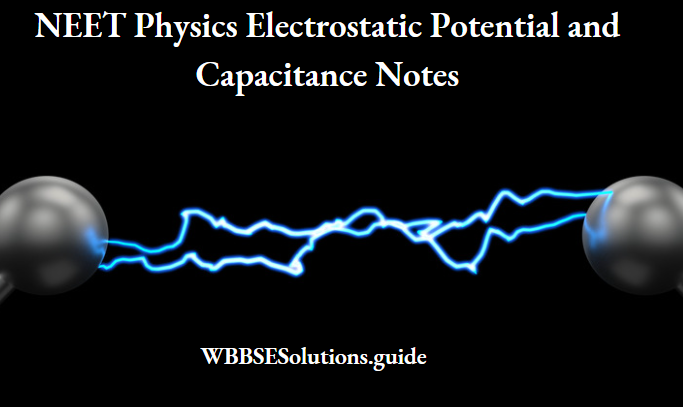NEET Physics Electrostatic Potential and Capacitance Notes
Electrostatic Potential And Capacitance
Electrostatic Potential Definition:
The electric potential at a point is defined as the work done in bringing a unit positive charge (with uniform speed) from infinity to that point against the electrostatic force of the field.
V = \(\frac{W}{q}\)
Charges always flow from a body at a higher potential to a body at a lower potential.
Electric potential due to a point charge is given by,
\(\mathrm{V}=\frac{1}{4 \pi \varepsilon_0} \frac{\mathrm{q}}{\mathrm{r}}\)Read And Learn More: NEET Physics Notes
Electric potential is a scalar quantity.
\(1 \text { volt }=\frac{1 \text { joule }}{1 \text { coulomb }} \Rightarrow 1 \mathrm{~V}=\frac{1 \mathrm{~J}}{1 \mathrm{C}}\)The electric potential at any general point due to a dipole is given by
\(\mathrm{V}=\frac{1}{4 \pi \varepsilon_0} \frac{\mathrm{p} \cos \theta}{\mathrm{r}^2}\)Best Notes for Electrostatic Potential and Capacitance NEET
Where ‘p’ is electric dipole moment θ, is the angle between \(\overrightarrow{\mathrm{r}} \text { and } \overrightarrow{\mathrm{p}}\).
A surface with the same value of potential at all points on the surface is known as an equipotential surface.
The p.d. between any two points on the equipotential surface is zero.
The work done in transferring a charge from one point to another on an equipotential surface is zero.
Electric Field and Potential Are Related as
E = \(\frac{dV}{dr}\)
Where \(\frac{dV}{dr}\) is known as a potential gradient.
The potential energy of a system of two charges is given by,
\(\mathrm{U}=\frac{1}{4 \pi \varepsilon_0} \frac{\mathrm{q}_1 \mathrm{q}_2}{\mathrm{r}_{12}}\)Where r12 is the distance between two charges.
The potential energy of a system of three charges is given by,
NEET Previous Year Questions on Electrostatic Potential and Capacitance
\(\mathrm{U}=\frac{1}{4 \pi \varepsilon_0}\left[\frac{\mathrm{q}_1 \mathrm{q}_2}{\mathrm{r}_{12}}+\frac{\mathrm{q}_1 \mathrm{q}_3}{\mathrm{r}_{13}}+\frac{\mathrm{q}_2 \mathrm{q}_3}{\mathrm{r}_{23}}\right]\)In general, for ‘n’ charges.
\(\mathrm{U}=\frac{1}{4 \pi \varepsilon_0} \sum_{\text {alpuis }} \frac{\mathrm{q}_{\mathrm{i}} \mathrm{q}_{\mathrm{j}}}{\mathrm{r}_{\mathrm{ij}}}\)The atoms or molecules in which the effective positive charge center and negative charge center do not coincide are called polar molecules.
A dielectric made of polar molecules is called a polar dielectric. The atoms or molecules in which the effective positive charge center and negative charge center coincide are called non–polar molecules.
A dielectric made of non–polar molecules is called non–polar dielectric.
The dipole moment per unit volume of the dielectric is called polarisation.
Polarisation, \(P=\chi_e E\)
Where Xe is known as the electrical susceptibility of the dielectric medium.
When a very high electric field is applied to the insulator, the force experienced by the valence electrons may be large enough to get pulled from the atom. Now electrons constitute current inside the insulator. This is known as the breakdown of dielectric or the breakdown of an insulating material.
The minimum value of an electric field that produces a breakdown of the dielectric is known as the dielectric strength of the dielectric.
NCERT Summary of Electrostatic Potential and Capacitance for NEET
Reason for Lightening
When the electric field developed by the charged cloud becomes greater than the dielectric strength of air, then there will be a huge electric discharge. This is the reason for lightening.
The dielectric strength of dry air is about 3×106V/m.
The capacitor is a device that stores energy in the form of an electric field.
Or
It is a system of two conductors separated by a distance used to store electric charge.
The capacitance of a capacitor ‘C’ is given by
\(\frac{Q}{V}\)Where ‘Q’ is the charge stored and ‘V’ is the potential difference.
Note:
A single conductor also has the capacity to store charges.
The capacitance of a spherical conductor is given by,
\(\mathrm{C}=\frac{\mathrm{Q}}{\mathrm{V}}=\frac{\mathrm{Q}}{\frac{1}{4 \pi \varepsilon_0} \frac{\mathrm{Q}}{\mathrm{R}}}\) \(\mathrm{C}=4 \pi \mathrm{x}_0 \mathrm{R}\)Where ‘R’ is the radius of the conductor.
The capacitance of a parallel plate air capacitor is given by,
\(C=\frac{\varepsilon_p A}{d}\)Where ‘A’ is the area of capacitor plates and ‘d’ is the distance between capacitor plates.
Step-by-Step Solutions for Electrostatic Potential NEET Problems
When a parallel plate capacitor is filled with a dielectric of dielectric constant ‘K’ then,
\(C=K\left(\frac{\varepsilon_0 A}{d}\right)\)i.e., the capacitance increases K times.
The capacitance of a capacitor when it is partially filled with dielectric
\(C=\frac{\varepsilon_0 A}{(d-t)+\frac{t}{K}}\)Where ‘t’ is the thickness of the dielectric slab.
The capacitance of a parallel plate capacitor with a conducting slab.
\(\mathrm{C}=\frac{\varepsilon_0 \mathrm{~A}}{\mathrm{~d}-\mathrm{t}}\)(∵ for a conducting slab K= ∞)
Series Combination of Capacitors
When capacitors are connected in series charge stored in all the capacitors is the same.
The effective capacitance is,
\(\frac{1}{C_5}=\frac{1}{C_1}+\frac{1}{C_2}+\ldots . .+\frac{1}{C_E}\)When two capacitors of capacitance C1 and C2 are connected in series, then,
\(\frac{1}{C_s}=\frac{1}{C_1}+\frac{1}{C_2}=\frac{C_1+C_2}{C_1 C_2}\) \(\mathrm{C}_{\mathrm{S}}=\frac{\mathrm{C}_1 \mathrm{C}_2}{\mathrm{C}_1+\mathrm{C}_2}\)When ‘n’ capacitors of equal capacitance ‘C’ are connected in series, then
\(\mathrm{C}_{\mathrm{S}}=\frac{\mathrm{C}}{\mathrm{n}}\)
Parallel Combination of Capacitors
When ‘n’ capacitors are connected in parallel, the p.d. between each capacitor will be the same.
The effective capacitance is,
Cp= C1 + C2 + …. + Cn
When ‘n’ capacitors of equal capacitance ‘C’ are connected in parallel, then
\(\mathrm{C}_{\mathrm{p}}=\mathrm{nC}\)The p.d. between two spherical shells of a spherical capacitor is given by,
\(V=\frac{Q}{4 \pi \varepsilon_0}\left[\frac{1}{a}-\frac{1}{b}\right]\)Where Q is the magnitude of charge on either shell, a is the radius of the inner shell and b is the radius of the outer shell.
Concept of Equipotential Surfaces and Potential Energy for NEET
∴ The capacitance of the spherical capacitor is,
\(\begin{aligned}& C=\frac{Q}{V} \\
& C=\frac{4 \pi \varepsilon_0 a b}{b-a}
\end{aligned}\)
Energy Stored On A Capacitor Is Given By:
\(\mathrm{U}=\frac{\mathrm{Q}^2}{2 \mathrm{C}}=\frac{1}{2} \mathrm{CV}^2=\frac{1}{2} \mathrm{QV}\)Note:
When a battery supplies charge to a capacitor, only 50% of the work done by the battery gets stored as energy. The remaining 50% is dissipated in the form of heat.
The Energy Density in a Parallel Plate Capacitor
\(\)u = \(\frac{U}{V}\)
\(\mathrm{u}=\frac{\frac{1}{2} \mathrm{CV}^2}{\mathrm{Ad}}=\frac{1}{2} \frac{\varepsilon_{\mathrm{g}} \mathrm{A} \mathrm{V}^2}{\mathrm{~d}(\mathrm{Ad})}\)\(\mathrm{u}=\frac{1}{2} \varepsilon_0 \mathrm{E}^2\) (∴ E = \(\frac{V}{d}\)
Parallel Plate Capacitor and Energy Stored NEET Questions
Common potential when two capacitors are connected in parallel
\(\mathrm{V}_{\text {coev }}=\frac{\mathrm{C}_1 \mathrm{~V}_1+\mathrm{C}_2 \mathrm{~V}_2}{\mathrm{C}_1+\mathrm{C}_2}\)The energy loss is given by,
\(\mathrm{U}_{\mathrm{leas}}=\frac{1}{2}\left(\frac{\mathrm{C}_1 \mathrm{C}_2}{\mathrm{C}_1+\mathrm{C}_2}\right)\left(\mathrm{V}_1-\mathrm{V}_2\right)^2\)